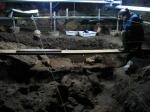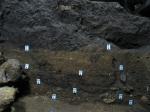Summary (English)
The aim of the 2016 campaign was to make an in-depth examination of the deposit underlying US 5 in quadrants R15 and Q15. This contained no archaeological material (lithics or macro-fauna associated with human occupation), but was very rich in micro mammals that are certainly Pleistocenic, given the position of US 5 below the Palaeolithic horizon, dated to 13615±75 BP. The trench, limited to these two quadrants for logistical reasons (the abundance of micro mammals and therefore the substantial time required for sorting), aimed to investigate the layer underlying US 5, which in the small sondage dug in 1981 had produced macro faunal remains of wolf, deer and ox, probably relating to human occupation. In R15, at the roof of US 6, a new layer US6Ø was exposed. Constituted by a blackish sandy clay sediment, about 15 cm thick in section 6, which produced other osteological materials, in particular two fragmentary wolf jaw bones, of the type found in 1981, in addition to a few micro faunal remains.
The underlying US6 was constituted by a sandy clay sediment with a skeleton of travertine fragments and micro limestone cobbles, whose variable thickness reached 40 cm in section 1. Lacking any internal sedimentological changes it was excavated in spits (only from t.1-3 to t.4-5 in quadrant Q15 and from t.1-3 to t.7-8 in R15, where underlying US7 was reached. US 6 contained an exceptional quantity of micro mammals, particularly in the first spits (c. 738 g in t. 1-3 in the two quadrants equal to c. 37,000 fragments. The layer also produced the remains of micro fauna, in both the upper and lower parts, the remains of birds, small fragments of marine bivalves and gastropods, some of the latter intact examples of the Bittium reticulatum type, and charcoal fragments dispersed throughout the sediment. Traces of small lithics were also present, including an intact marginal back blade found low down in quadrant R15.The nature of the sediment (predominantly clay and without internal structures and the constant presence of micro cobblestones that certainly came from outside the cave) and the distribution of the macro fauna within it, suggest it was accumulated here by surface water in this point of the cave. However, the build up of this accumulation would have damaged the nearby archaeological level, causing the removal of macro-fauna, charcoal, marine shells, and lithic industry. For the moment this is just a working hypothesis, which needs to be checked during the next campaign, with an in depth excavation a few metres away in the area of the main trench, where it is thought an intact archaeological level may be present below US 5. C14 dating to be carried out on the charcoal samples will ascertain the chronological position of this new horizon.
- Attilio Galiberti-Dipartimento di Scienze Storiche e dei Beni Culturali – Università di Siena
- Mauro Calattini - Università degli Studi di Siena, Dipartimento di Archeologia e Storia delle Arti, Sezione di Preistoria
Director
- Mauro Calattini- Dipartimento di Scienze Storiche e dei Beni Culturali – Università di Siena
Team
- Studenti del Dipartimento di Scienze Storiche e dei Beni Culturali e membri dell’Associazione Archeologica Piombinese
Research Body
- Università degli Studi di Siena
Funding Body
- Università degli Studi di Siena






![Download [PDF]](/excavation/skins/fasti/images/results/download_sml.png)
